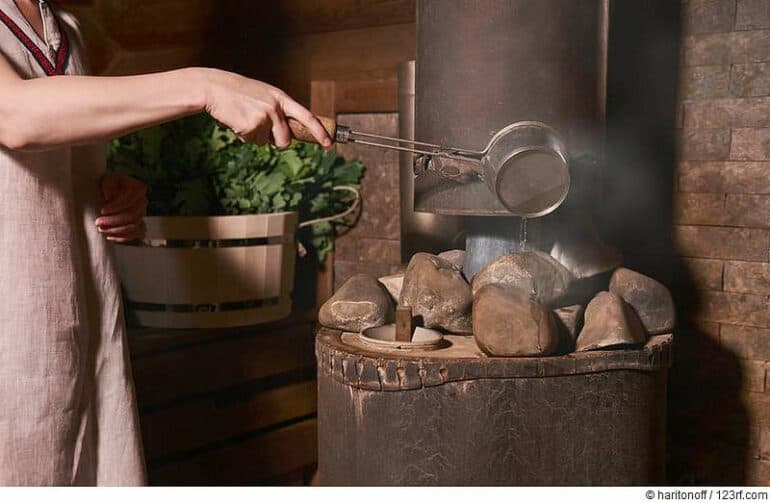Natural indoor climate with suitable sauna stones
In a sauna, the sauna stones play a very important role. They store the heat, are responsible for the temperature and also for the steam that we enjoy so much. But sauna stones also have certain properties that can affect the sauna climate. And we’ll take a closer look at these here.
What types of rocks are there for the sauna heater?
Several types of rocks are popular among sauna fans, but igneous (volcanic) rocks are first and foremost. There are numerous reasons why sauna lovers choose lava rock – it absorbs heat excellently, is robust, does not burst and is extremely durable. Most granite rocks have a lighter coloration and are always speckled. If the granite comes from a mineral-rich quarry that has been exposed to high pressure, it is particularly resilient. Such a resilient granite is, for example, olivine diabase, which also has a high heat storage capacity. Diorite, feldspar, gebbro, pyroxene, olivine and peridotite would also be recommended. All of the above minerals are very efficient heat accumulators. In addition, they are characterized by their homogeneous surface as well as a certain elasticity.
Synthetic sauna stones
To ensure constant availability, manufacturers now also produce synthetic sauna stones. They are of natural origin, but have, for example, specially hardened surfaces. However, fully synthetic ceramic stones are also available. Synthetic sauna stones have a much longer life than the untreated stones. However, a traditional infusion succeeds only with natural stones.
What size should sauna stones be?
When buying sauna stones, make sure that they are pre-washed to prevent dirt and suspended matter from burning. It is optimal if the sauna stones have a size of 5-10 cm. The larger the stones, the longer the heat is stored in them. This saves electricity costs in the long term and significantly increases the life of the stones.
How should the sauna stones be placed?
By following the guidelines below, you can achieve longer sauna stone life and higher quality steam and heat.
- Remove any dirt from the stones before placing them on the sauna heater.
- Sort the stones according to their size. Mainly medium-sized stones should be used. Fill in gaps with small stones, for example, around the heating element. If you have large stones available, place them near the heating element and not on the edges of the furnace.
- Make full use of the surface area of the vessel, but avoid putting pressure on the heating components.
- To maximize heat conduction, leave just enough space between stones to allow adequate airflow, but avoid large gaps.
- Dark stones absorb heat better than light stones. If you like light-colored stones, fill up the basket with dark stones on the inside and light-colored stones near the outside.
Frequently asked questions
What are sauna stones?
Sauna stones are among the stones that are suitable for the sauna heater. These stones are needed to maintain the desired temperature in the sauna. They are also used to increase the humidity in the sauna by pouring water over the hot stones. In addition, sauna stones make the sauna safer to use, as a sauna heater alone without stones is a fire hazard.
How often should I replace my sauna stones?
At the latest, when you discover the first cracks and fractures, you need to act. But don’t just pay attention to the top layer. Check all your stones carefully at appropriate intervals. At the very latest, you should do this for the first time after half a year. If the sauna is used for several hours a day, it is even recommended to check it monthly.
By replacing the stones, you prolong their life and postpone the time of replacement. The reason is that the lower stones are exposed to more heat, and if you leave them there, they will wear out faster than the upper ones. If you switch places, you’ll even out the wear and tear, so you can use the stones longer.
How much infusion water can my sauna stones handle?
It is recommended to use a smaller amount of water when infusing the stones, and this has several understandable reasons. It is easier on the stones – you get a nice steam without affecting the temperature of the sauna stones. If you use too much water, the stones can cool down and you run the risk of flooding the heater, which is something you should avoid at all costs. Using cold water will produce a better steam, but the stones will also cool down faster. Ultimately, it all depends on your personal preferences and the length of time you spend in the sauna, but we generally recommend not overdoing it.
Why do my sauna stones break?
Worn sauna stones that crack no longer have the density necessary to adequately retain heat. If they are brittle, they can no longer absorb the infusion water and will crumble when exposed to high heat.
Bestsellers: The 6 most popular sauna stones on Amazon
Here you can find a daily bestseller list for the topic: sauna stones
| # | Preview | Product | Price | |
|---|---|---|---|---|
| 1 |
|
Original Harvia Saunasteine 20Kg finnische Diabas Dampfstein...* | 34,49 EUR | Zum Angebot |
| 2 |
|
HarzStone Saunasteine 20kg – Perfekte Hitze, schnelles...* | 28,90 EUR | Zum Angebot |
| 3 |
|
Schicker Mineral Deutsche Saunasteine 10 kg, hochwertige...* | 21,49 EUR 19,99 EUR | Zum Angebot |
| 4 |
|
Harvia Saunasteine 20 kg* | 39,90 EUR 34,49 EUR | Zum Angebot |
| 5 |
|
Doubleyou Geovlies & Baustoffe | Saunasteine Premium 5 kg |...* | 17,99 EUR 15,99 EUR | Zum Angebot |
| 6 |
|
HARVIA Saunazubehör Saunasteine 20kg 5-10cm* | 27,70 EUR | Zum Angebot |

